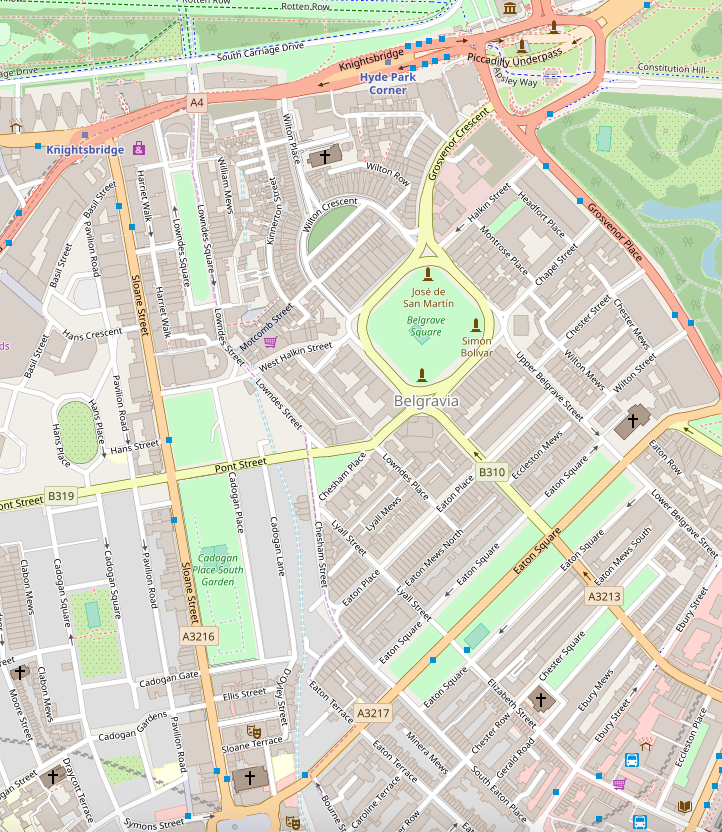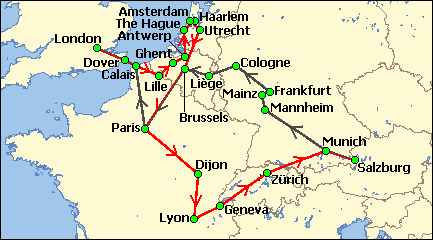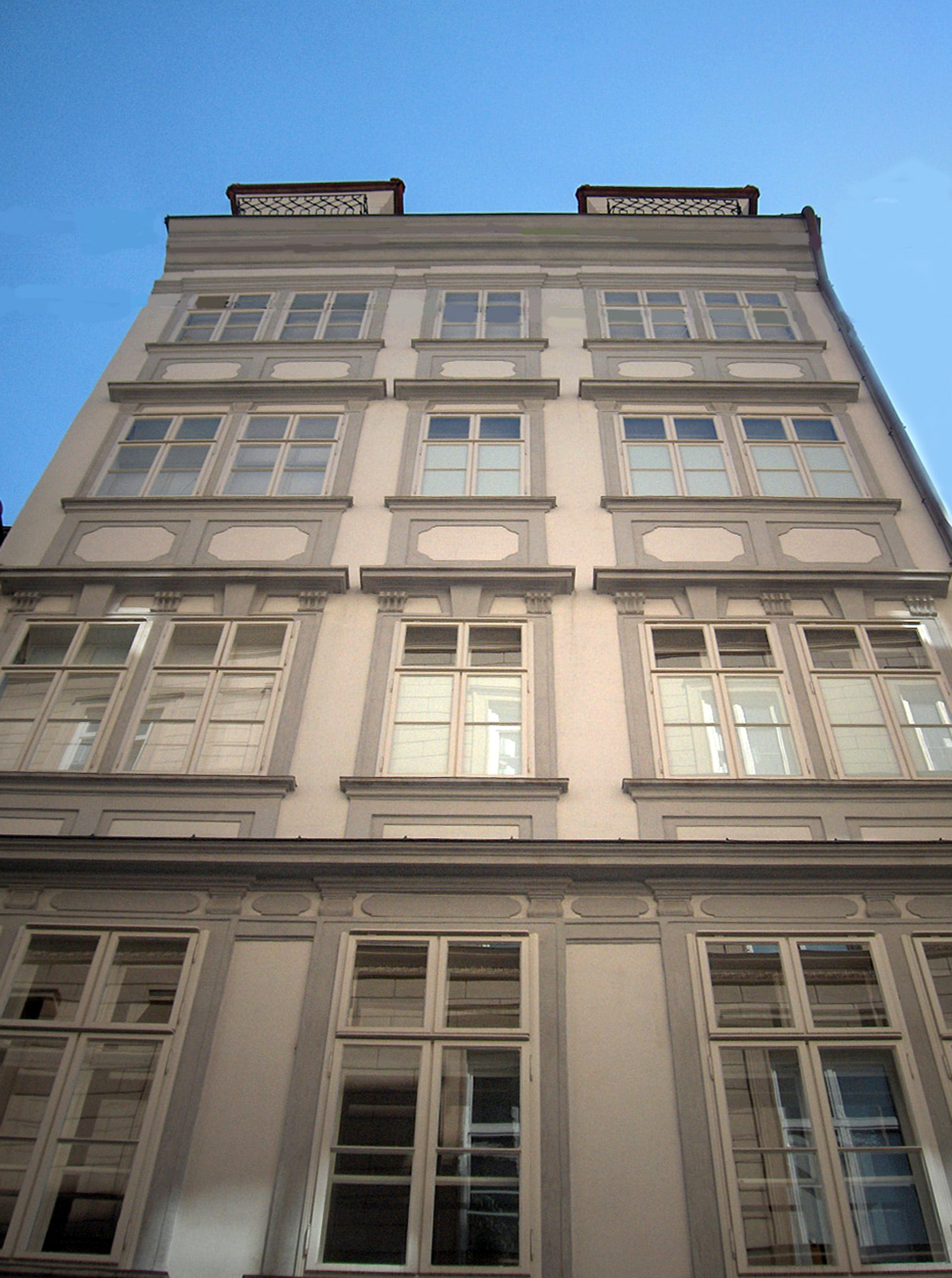|
180 Ebury Street
180 Ebury Street in the Belgravia district of London was the home of the composer Wolfgang Amadeus Mozart and his family from 5 August 1764 to 24 September 1764 during the Mozart family's grand tour of Europe. The house was built in the early to mid-eighteenth century as part of a terrace. Mozart composed his first symphony here in 1764. The house has been listed at Grade I due to its association with Mozart. The building is now marked with a London County Council plaque placed in 1939 to commemorate Mozart's residence. The plaque was re-erected in 1951 following damage in the Second World War. WOLFGANG AMADEUS MOZART 1756-1791 composed his first symphony here in 1764 (cropped).JPG, The plaque marking Mozart's residence See also *Mozarthaus Vienna *20 Frith Street 20 Frith Street is a building in the Soho district of London. It is located on the east side of Frith Street, close to the junction with Old Compton Street. The building which currently occupies the site ... [...More Info...] [...Related Items...] OR: [Wikipedia] [Google] [Baidu] |
Belgravia
Belgravia () is a Districts of London, district in Central London, covering parts of the areas of both the City of Westminster and the Royal Borough of Kensington and Chelsea. Belgravia was known as the 'Five Fields' Tudor Period, during the Tudor Period, and became a dangerous place due to Highwayman, highwaymen and robberies. It was developed in the early 19th century by Richard Grosvenor, 2nd Marquess of Westminster under the direction of Thomas Cubitt, focusing on numerous grand terraces centred on Belgrave Square and Eaton Square. Much of Belgravia, known as the Grosvenor Group#The Grosvenor Estate, Grosvenor Estate, is still owned by a family property company, the Duke of Westminster's Grosvenor Group, although owing to the Leasehold Reform Act 1967, the estate has been forced to sell many Freehold (law), freeholds to its former tenants. Geography Belgravia is near the former course of the River Westbourne, a tributary of the River Thames. The area is mostly in the Cit ... [...More Info...] [...Related Items...] OR: [Wikipedia] [Google] [Baidu] |
Wolfgang Amadeus Mozart
Wolfgang Amadeus Mozart (27 January 17565 December 1791), baptised as Joannes Chrysostomus Wolfgangus Theophilus Mozart, was a prolific and influential composer of the Classical period. Despite his short life, his rapid pace of composition resulted in more than 800 works of virtually every genre of his time. Many of these compositions are acknowledged as pinnacles of the symphonic, concertante, chamber, operatic, and choral repertoire. Mozart is widely regarded as among the greatest composers in the history of Western music, with his music admired for its "melodic beauty, its formal elegance and its richness of harmony and texture". Born in Salzburg, in the Holy Roman Empire, Mozart showed prodigious ability from his earliest childhood. Already competent on keyboard and violin, he composed from the age of five and performed before European royalty. His father took him on a grand tour of Europe and then three trips to Italy. At 17, he was a musician at the Salzburg court b ... [...More Info...] [...Related Items...] OR: [Wikipedia] [Google] [Baidu] |
Mozart Family Grand Tour
The Mozart family grand tour was a journey through western Europe, undertaken by Leopold Mozart, his wife Anna Maria, and their musically gifted children Maria Anna (Nannerl) and Wolfgang Theophilus (Wolferl) from 1763 to 1766. At the start of the tour the children were aged eleven and seven respectively. Their extraordinary skills had been demonstrated during a visit to Vienna in 1762, when they had played before the Empress Maria Theresa at the Imperial Court. Sensing the social and pecuniary opportunities that might accrue from a prolonged trip embracing the capitals and main cultural centres of Europe, Leopold obtained an extended leave of absence from his post as deputy Kapellmeister to the Prince-Archbishopric of Salzburg. Throughout the subsequent tour, the children's ''Wunderkind'' status was confirmed as their precocious performances consistently amazed and gratified their audiences. The first stage of the tour's itinerary took the family, via Munich and Frankfurt, ... [...More Info...] [...Related Items...] OR: [Wikipedia] [Google] [Baidu] |
Symphony No
A symphony is an extended musical composition in Western classical music, most often for orchestra. Although the term has had many meanings from its origins in the ancient Greek era, by the late 18th century the word had taken on the meaning common today: a work usually consisting of multiple distinct sections or movements, often four, with the first movement in sonata form. Symphonies are almost always scored for an orchestra consisting of a string section (violin, viola, cello, and double bass), brass, woodwind, and percussion instruments which altogether number about 30 to 100 musicians. Symphonies are notated in a musical score, which contains all the instrument parts. Orchestral musicians play from parts which contain just the notated music for their own instrument. Some symphonies also contain vocal parts (e.g., Beethoven's Ninth Symphony). Etymology and origins The word ''symphony'' is derived from the Greek word (), meaning "agreement or concord of sound", "concert of ... [...More Info...] [...Related Items...] OR: [Wikipedia] [Google] [Baidu] |
Listed Building
In the United Kingdom, a listed building or listed structure is one that has been placed on one of the four statutory lists maintained by Historic England in England, Historic Environment Scotland in Scotland, in Wales, and the Northern Ireland Environment Agency in Northern Ireland. The term has also been used in the Republic of Ireland, where buildings are protected under the Planning and Development Act 2000. The statutory term in Ireland is " protected structure". A listed building may not be demolished, extended, or altered without special permission from the local planning authority, which typically consults the relevant central government agency, particularly for significant alterations to the more notable listed buildings. In England and Wales, a national amenity society must be notified of any work to a listed building which involves any element of demolition. Exemption from secular listed building control is provided for some buildings in current use for worship, ... [...More Info...] [...Related Items...] OR: [Wikipedia] [Google] [Baidu] |
London County Council
London County Council (LCC) was the principal local government body for the County of London throughout its existence from 1889 to 1965, and the first London-wide general municipal authority to be directly elected. It covered the area today known as Inner London and was replaced by the Greater London Council. The LCC was the largest, most significant and most ambitious English municipal authority of its day. History By the 19th century, the City of London Corporation covered only a small fraction of metropolitan London. From 1855, the Metropolitan Board of Works (MBW) had certain powers across the metropolis, but it was appointed rather than elected. Many powers remained in the hands of traditional bodies such as parishes and the counties of Middlesex, Surrey and Kent. The creation of the LCC in 1889, as part of the Local Government Act 1888, was forced by a succession of scandals involving the MBW, and was also prompted by a general desire to create a competent government fo ... [...More Info...] [...Related Items...] OR: [Wikipedia] [Google] [Baidu] |
Blue Plaque
A blue plaque is a permanent sign installed in a public place in the United Kingdom and elsewhere to commemorate a link between that location and a famous person, event, or former building on the site, serving as a historical marker. The term is used in the United Kingdom in two different senses. It may be used narrowly and specifically to refer to the "official" scheme administered by English Heritage, and currently restricted to sites within Greater London; or it may be used less formally to encompass a number of similar schemes administered by organisations throughout the UK. The plaques erected are made in a variety of designs, shapes, materials and colours: some are blue, others are not. However, the term "blue plaque" is often used informally to encompass all such schemes. The "official" scheme traces its origins to that launched in 1866 in London, on the initiative of the politician William Ewart, to mark the homes and workplaces of famous people. It has been administe ... [...More Info...] [...Related Items...] OR: [Wikipedia] [Google] [Baidu] |
English Heritage
English Heritage (officially the English Heritage Trust) is a charity that manages over 400 historic monuments, buildings and places. These include prehistoric sites, medieval castles, Roman forts and country houses. The charity states that it uses these properties to "bring the story of England to life for over 10 million people each year". Within its portfolio are Stonehenge, Dover Castle, Tintagel Castle and the best preserved parts of Hadrian's Wall. English Heritage also manages the London Blue Plaque scheme, which links influential historical figures to particular buildings. When originally formed in 1983, English Heritage was the operating name of an executive non-departmental public body of the British Government, officially titled the Historic Buildings and Monuments Commission for England, that ran the national system of heritage protection and managed a range of historic properties. It was created to combine the roles of existing bodies that had emerged from a long ... [...More Info...] [...Related Items...] OR: [Wikipedia] [Google] [Baidu] |
Mozarthaus Vienna
The Mozarthaus Vienna was Mozart's residence from 1784 to 1787. This building in Vienna's Old Town, not far from St. Stephen's Cathedral, is his only surviving Viennese residence and is now a museum. History The house is located on Domgasse. It was built in the 17th century, originally with two floors, and redeveloped in 1716. Mozart rented rooms here from 1784, at which time it was also known as the Camesina House, after the family which had owned it since 1720. Since the original entrance of the house facing the Schulerstraße (the one Mozart used) was walled up to make room for a shop, the house has to be entered today from its rear in the Domgasse. In 1941, the 150th anniversary of Mozart's death, his former rooms were opened to the public as part of "Imperial German Mozart Week", a National Socialist event intended to honour him as a "typically German" composer (in contrast to his polyglot lifestyle). In 1945 the running of the exhibition was taken over by the Vienna Museum. ... [...More Info...] [...Related Items...] OR: [Wikipedia] [Google] [Baidu] |
20 Frith Street
20 Frith Street is a building in the Soho district of London. It is located on the east side of Frith Street, close to the junction with Old Compton Street. The building which currently occupies the site of 20 Frith Street was built in 1858 by William Cooze to replace a house which dated from c1725, which itself may have replaced an even earlier building. When the house was built in around 1725 there were fewer houses in the street (which for a period was named Thrift Street), because the north end was taken up by Monmouth House. At the time, the grounds of Monmouth House (now demolished) extended from the south side of Soho Square to Queen Street (now Bateman Street); and so during some of the eighteenth century the house's address was 15 Thrift Street. The most famous inhabitant at this address was Wolfgang Amadeus Mozart, who lived there aged eight from September 1764 during his grand tour of Europe with his father and his sister. The site gained its current address of No. ... [...More Info...] [...Related Items...] OR: [Wikipedia] [Google] [Baidu] |
Grade I Listed Buildings In The City Of Westminster
There are over 9,000 Grade I listed buildings in England. This page is a list of these buildings in the City of Westminster The City of Westminster is a City status in the United Kingdom, city and London boroughs, borough in Inner London. It is the site of the United Kingdom's Houses of Parliament and much of the British government. It occupies a large area of cent .... Buildings Bayswater Belgravia Buckingham Palace complex Charing Cross / Trafalgar Square Covent Garden Hyde Park Kensington Kilburn Maida Vale Marylebone Mayfair Paddington Pimlico Regent's Park St James's Soho Strand Temple Victoria Victoria Embankment Westminster Abbey Precinct and Westminster School Whitehall See also * Grade II* l ... [...More Info...] [...Related Items...] OR: [Wikipedia] [Google] [Baidu] |
Grade I Listed Houses In London
Grade most commonly refers to: * Grade (education), a measurement of a student's performance * Grade, the number of the year a student has reached in a given educational stage * Grade (slope), the steepness of a slope Grade or grading may also refer to: Music * Grade (music), a formally assessed level of profiency in a musical instrument * Grade (band), punk rock band * Grades (producer), British electronic dance music producer and DJ Science and technology Biology and medicine * Grading (tumors), a measure of the aggressiveness of a tumor in medicine * The Grading of Recommendations Assessment, Development and Evaluation (GRADE) approach * Evolutionary grade, a paraphyletic group of organisms Geology * Graded bedding, a description of the variation in grain size through a bed in a sedimentary rock * Metamorphic grade, an indicatation of the degree of metamorphism of rocks * Ore grade, a measure that describes the concentration of a valuable natural material in the surroun ... [...More Info...] [...Related Items...] OR: [Wikipedia] [Google] [Baidu] |





.jpg)


